Pump Handbook by Igor J. Karassik, Joseph P. Messina, Paul Cooper, Charles C. Heald - 3rd edition
Подождите немного. Документ загружается.


9.10 CHAPTER NINE
FIGURE 4 Typical section of the Forney raw water pumping station in Dallas, showing pump suction and
discharge piping (1 in = 2.54 cm; 1 ft = 0.3048 m) (URS/Forrest and Cotton)
have proved effective in minimizing surges and should be considered for pump check ser-
vice if economically feasible.
Manifolding of suction and discharge headers is common practice in the design of
pumping stations because parallel operation can be readily achieved with such an arrange-
ment. Suction headers may be located directly below the pumps (Figure 4) or along the out-
side wall of the pump station (Figure 5), depending on the location of the intake structure
and the configuration of the suction piping. Interconnection of discharge headers (Figure
6) provides additional system flexibility and added protection in the event of line breakage.
Pump Drivers The waterworks industry has evolved to the point of almost exclusive
use of electric motors as pump drivers. Diesel or gasoline engines may be used as emer-
gency drivers or as the primary drivers where reliable electric power is not available. How-
ever, the high costs of continuous operation and the limitations of rotative speed preclude
the use of diesel or gasoline drivers in most installations.
Although some dc motors are used in the waterworks industry, the great majority of
electric motors used as pump drivers are ac motors of the squirrel-cage-induction, wound-
rotor, or synchronous type. Hydraulic or magnetic variable-speed devices can be used in
conjunction with the pump driver to vary pumping rates in accordance with demand.
System-Head Curves The capacity of a pumping installation cannot be determined
without an accurate determination of the head requirements of the system. Consequently,
a system-head curve must be derived, depicting calculated losses through the system for
various pumping rates. The construction of a system-head curve must be based upon a
logical sequence of determinations of the various components of system losses.
A preliminary sketch or schematic should be derived, showing the configuration and
size of suction and discharge piping, including all pipe, valves, and fittings.
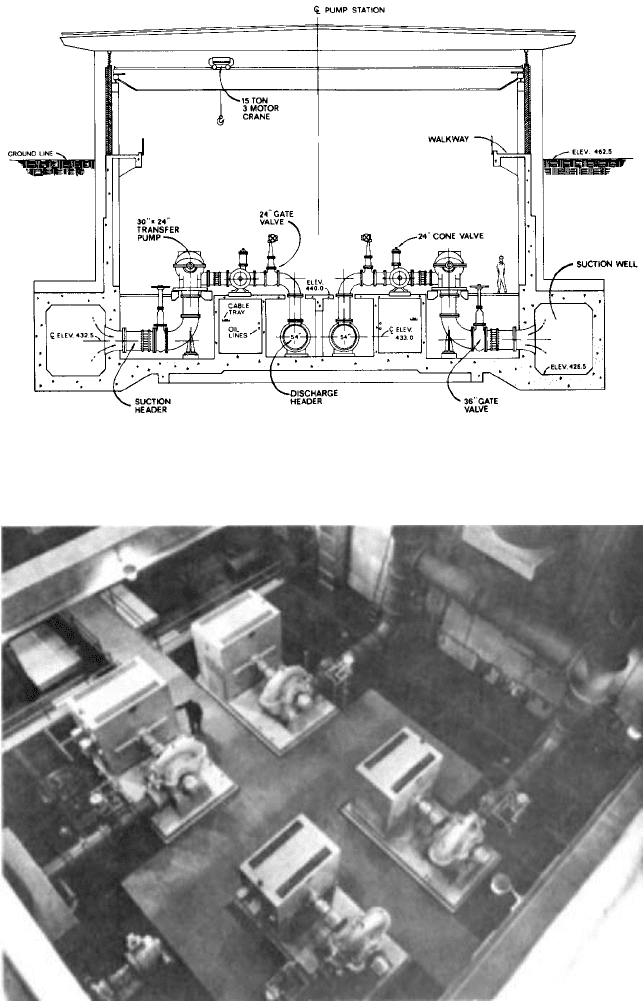
9.1 WATER SUPPLY 9.11
FIGURE 5 Typical section of the high-service pumping station of the East Side water treatment plant in Dallas
(1 in = 2.54 cm; ft = 0.3048 m) (URS/Forrest and Cotton)
FIGURE 6 Dallas Iron Bridge 100-mgd (3.78 105 m
3
/day) raw water pumping station, showing layout with
bottom-suction, side-discharge pumping units (URS/Forrest and Cotton)
9.12 CHAPTER NINE
FRICTIONAL LOSSES
Frictional loss in the discharge piping can be determined for various
pumping rates from the formula:
In US units (1a)
In SI units (1b)
where h
f
head loss, ft (m)
K a constant depending on pipe size and friction factor C
Q flow, mgd (m
3
/h)
Equation 1 is a modification of the basic Hazen-Williams formula for the special case
of circular pipes flowing full. Values of 10
5
K for various pipe sizes and friction factors are
listed in Table 2. Common practice has been to design systems on the basis of C 100.
However, investigations for the Dallas Water Utilities have indicated that a regulated
cleaning program for pipelines can result in sustained values of C as high as 135 or 140.
Accordingly, consideration should be given to providing for periodic cleaning of pipelines
so the initial design capacity of the pumping units can be sustained.
To demonstrate the use of Eq. 1, assume that it is desired to compute the head losses
due to pipe friction as a result of pumping at a rate of 30 mgd (4730 m
3
/h) through 1050 ft
(320 m) of 36-in diameter (914.4-mm) pipe having a friction factor of 130. From Table 2,
10
5
K 0.610 or unit K 0.00000610:
In USCS units
In SI units
Entrance and exit losses and losses through valves and fittings can be calculated from
the data in Section 8.1.
STATIC HEAD AND PRESSURE DIFFERENTIAL
In computing total system head, consideration
must be given to the effects of static head and pressure differential. Static head can be
calculated simply from the difference in elevation between supply level and discharge
level, and differential pressure can be calculated from the difference between terminal
pressure and suction pressure.
PUMP CHARACTERISTIC CURVES
The shape of a centrifugal pump curve must be considered
in selection of a specific pump. If, for example, the water level at the source of supply or
at the point of discharge is subject to wide variation, a pump with a steep characteristic
curve near the design point should be selected to minimize the effects of head variations
on pump capacity. Additionally, the pump shutoff head (or head of impending delivery)
must exceed the static head to ensure that the pump will operate upon opening of the dis-
charge valve.
NET POSITIVE SUCTION HEAD As a final step in selection of a specific pump for a particular
application, suction conditions should be investigated to determine the net positive suc-
tion head (NPSH) available. Failure to meet the NPSH requirements of the pump selected
will result in cavitation of the pump impeller and very low pumping efficiency.
TOTAL SYSTEM HEAD
The summation of all components of system head, as calculated for
various flows, results in a graphical plot of the system-head curve (Figure 7). To deter-
mine the capability of a specific centrifugal pump operating under system conditions, the
pump characteristic curve should be superimposed on the system-head curve. The inter-
section of the two curves then represents the capacity that the specific pump can deliver.
The construction of system-head curves is further discussed in Section 8.1.
h
f
2.618 10
5
0.006405 6.29 10
6
1.06 m
Q
1.85
4730
1.85
6.29 10
6
h
f
0.006405 540.3 3.46 ft
Q
1.85
30
1.85
540.3
Segmental K 0.00000610 1050 0.006405
hf 2.618 10
5
KQ
1.85
h
f
KQ
1.85

9.1 WATER SUPPLY 9.13
TABLE 2 Computed valued of 10
5
K for use in Eq. 1
Pipe
Hazen-Williams C value
diameter, in. 70 80 90 100 110 120 110 135 140
6 11,800 9,240 7.420 6,100 5,100 4,350 3,750 3,590 3,280
8 2,900 2,270 1,823 1,500 1,240 1,070 924 881 805
10 982 767 617 507 425 362 312 298 272
12 404 315 253 209 175 149 128.5 122.6 112.1
14 190 149 119.7 98.4 82.5 70.4 60.5 57.8 52.9
16 99.6 77.8 62.6 51.6 43.3 36.8 31.6 30.3 27.7
18 56.1 43.9 35.2 29.0 24.3 20.7 17.84 17.04 15.6
20 33.6 26.2 21.1 17.33 14.53 12.4 10.67 10.17 9.30
21 26.4 20.7 16.6 13.67 11.47 9.77 8.43 8.05 7.35
24 13.8 10.3 8.68 7.13 5.99 5.09 4.39 4.19 3.83
27 12.4 6.08 4.89 4.02 3.37 2.87 2.47 2.36 2.16
10 4.66 3.64 2.91 2.41 2.02 1.717 1.48 1.412 1.291
51 2.94 2.29 1.964 1.516 1.269 1.081 0.933 0.890 0.814
16 1.92 1.50 1.206 0.993 0.832 0.708 0.610 0.583 0.534
19 1.298 1.016 0.816 0.670 0.563 0.480 0.413 0.395 0.361
42 0.906 0.706 0.570 0.469 0.392 0.334 0.287 0.276 0.251
45 0.646 0.504 0.406 0.334 0.280 0.238 0.206 0.1964 0.1796
48 0.462 0.379 0.290 0.239 0.200 0.1702 0.1470 0.1401 0.1280
51 0.352 0.275 0.221 0.1816 0.1522 0.1296 0.1119 0.1067 0.0975
54 0.266 0.208 0.1673 0.1377 0.1152 0.0982 0.0848 0.0807 0.0738
57 0.204 0.160 0.1285 0.1056 0.0886 0.0753 0.0650 0.0621 0.0567
60 0.1594 0.1244 0.1000 0.0823 0.0691 0.0587 0.0507 0.0484 0.0442
63 0.1256 0.0982 0.0789 0.0650 0.0545 0.0464 0.0400 0.0382 0.0349
66 0.1000 0.0785 0.0630 0.0518 0.0434 0.0370 0.0319 0.0304 0.0278
69 0.0805 0.0630 0.0507 0.0417 0.0349 0.0298 0.0256 0.0245 0.0224
72 0.0655 0.0511 0.0412 0.0339 0.0284 0.0242 0.0209 0.01991 0.01820
75 0.0538 0.0414 0.0339 0.0278 0.0233 0.01982 0.01710 0.01632 0.01493
78 0.0444 0.0347 0.0279 0.0229 0.01924 0.01637 0.01413 0.01348 0.01231
81 0.0314 0.0289 0.0232 0.01906 0.01600 0.01360 0.01173 0.01121 0.01024
84 0.0309 0.0242 0.01942 0.01600 0.01340 0.01141 0.00984 0.00939 0.00859
90 0.0222 0.01730 0.01390 0.01143 0.00957 0.00816 0.00704 0.00672 0.00614
96 0.01614 0.01262 0.01013 0.00834 0.00700 0.00596 0.00513 0.00491 0.00448
102 0.01200 0.00939 0.00756 0.00621 0.00520 0.00444 0.00381 0.00365 0.00334
108 0.00910 0.00711 0.00572 0.00471 0.00395 0.00336 0.00289 0.00276 0.00253
120 0.00545 0.00426 0.00343 0.00283 0.00235 0.00200 0.00173 0.00165 0.00151
Note: In Eq. 1a,
K (1594/C)
1.85
(L/d
4.87
)(l/0.446)
C Hazen-Williams coefficient of pipe friction
D pipe length, ft; 10
5
K values are for L 1.0 ft and must be multiplied by true line
length to determine line segmental K
d pipe diameter, in
1 in 25.4 mn
Parallel and Series Operation The installation of multiple pumping units operating
in parallel is common practice in the waterworks industry because, with proper design
and regulation, it permits the most efficient use of pumping facilities and allows smooth
transitions in pumping rates as demand fluctuates. This type of operation is particularly
adaptable to pumpage from treatment facilities into a distribution system but is also
applicable to raw water pumpage, which is generally required to match treated water
pumpage. Special care must be taken in sizing the individual pumping units to ensure
efficient operation and to prevent units from operating significantly above or below design
rates during parallel operation. The principle upon which design must be based is that
total station discharge may be determined by adding the individual pump discharges asso-
ciated with any particular head. Obviously then, as additional pumps are placed in oper-
ation, the station flow will increase. However, because the system-head curve rises with
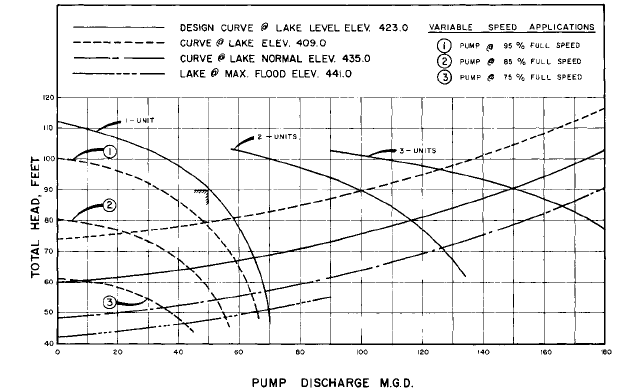
9.14 CHAPTER NINE
FIGURE 7 System-head curve for the Forney raw water pumping station of Dallas (1 ft = 0.3048 m;
1 mgd = 157.7 m
3
/h; elev. in ft 0.5048 = elev. in m) (URS/Forrest and Cotton)
increasing flow, the operation of two identical pumps in parallel will not produce a dis-
charge equal to twice the capacity of one pump. As more pumps are placed in operation,
the incremental increase in pumping capacity becomes smaller.
It should be noted that, when only a portion of the pumps are in operation (total sta-
tion flow is less than design capacity), the total system head is reduced and the individual
pumping units are thus operating at a rate exceeding the design capacity.
If flows are increased substantially past the design point, the NPSH available may
become inadequate and cavitation may occur. Additionally, the possibility of overloading
the pump driver is introduced, particularly in pumps designed for high heads. In selecting
a pumping unit, it is therefore necessary to check conditions at runout capacity (the max-
imum discharge and lowest head anticipated) in order to ensure proper pump operation.
The undesirable effects of operating a pump at capacities lower than design flow are
similar to those resulting from overpumping, but for different reasons. Low discharge
rates result in recirculation through the pump, causing cavitation, vibration, and noise.
Moreover, the radial force on the impeller increases substantially, thus increasing the
stress on the shaft and bearings (to an even greater extent than would result from over-
pumping). Drivers of pumps designed for low heads may be subjected to overload at low
capacities (and thus high heads).
In determining pumping capacities for series operation, heads are added. Thus two
identical pumps with capacity of 30 mgd (4730 m
3
/h) at 200 ft (60 m) of system head would,
if placed in series, discharge 30 mgd (4730 m
3
/h) at 200 ft (60 m) of system head. This type
of operation is frequently employed in raw water pumping stations in the form of multi-
stage, vertical turbine pumps and is frequently utilized to boost pressures in a distribution
system.
Variable-Speed Applications Installation of two or more variable-speed pumping units
will allow gradual increase or decrease of station discharge as dictated by demand. When
the required discharge is less than the capacity of two pumps, the variable-speed units
may be operated in parallel. Moreover, the installation of two variable-speed units per-
mits operation at flows in excess of the minimum allowable flow and ensures satisfactory
efficiency under all conditions. Figure 8 typifies the relationships between head, capacity,
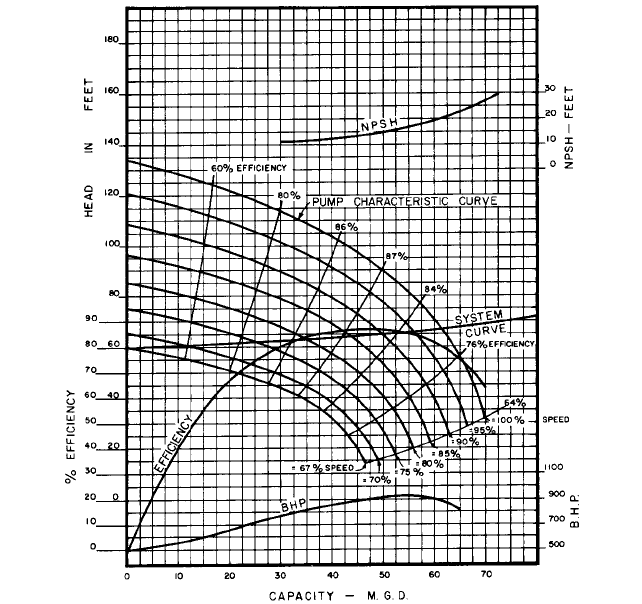
9.1 WATER SUPPLY 9.15
FIGURE 8 System-head curves for variable-speed operation for the Forney raw water pumping station in Dallas
(1 ft = 0.3048 m ; 1bhp = 0.746 bkW; 1 mgd = 157.7 m
3
/h) (URS/Forrest and Cotton)
and efficiency at varying speeds. Typical procedure for an installation with two variable-
speed units is as follows:
1. If station flow is less than the capacity of one pump, one variable-speed unit is
operated.
2. If station flow is between one and two times the capacity of a single unit, both
variable-speed units are operated (in lieu of operating one unit at full speed and the
other at a speed less than that required to produce minimum allowable flow).
3. If station flow is more than two times the capacity of a single unit, the two variable-
speed units are operated, along with as many constant-speed units as are required to
ensure operation of all pumps at speeds that will produce flows exceeding minimum
requirements.
USES OF PUMPS AT WATER TREATMENT PLANTS ________________________
Pumps are an integral part of virtually every water treatment plant in existence and have
a variety of uses, including low-lift service, coagulant feed, carbon slurry transfer and feed,
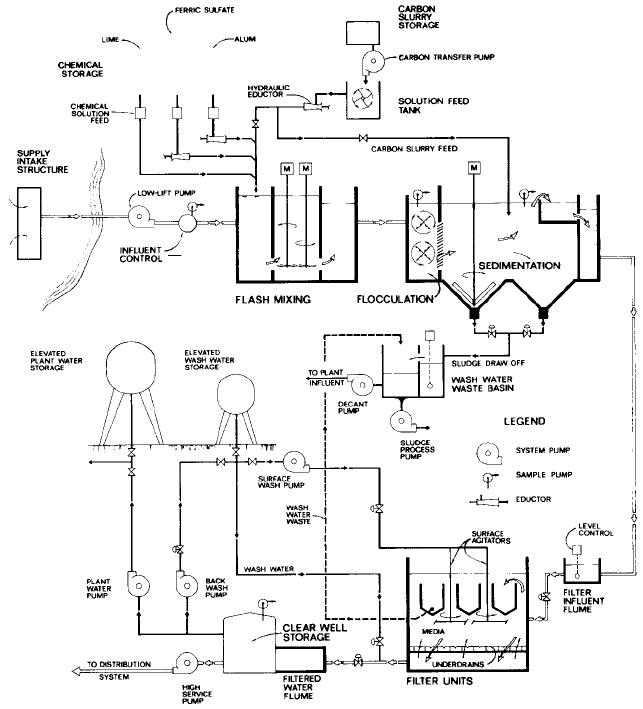
9.16 CHAPTER NINE
FIGURE 9 Typical flow diagram of water treatment plant, including raw water supply
fluoride feed, delivery of samples from selected points to the chemical laboratory, plant
water supply, wash water supply, surface wash supply, and high service pumpage to the
distribution system (Figure 9).
Low-Lift Pumps Low-lift pumps, located at either the source or the treatment site, are
often outdoor, weatherproof vertical pumps (Figure 10). They may also be horizontal cen-
trifugal pumps housed in a separate pumping station. Head and capacity requirements
are as discussed previously.
Coagulant Feed Pumps Pumps used in chemical feed applications are usually not cen-
trifugal because of the kinds of materials handled. More often, chemicals are fed by a jet
pump or hydraulic eductor that utilizes a moving stream of water to create a vacuum at
the suction port of the eductor. This type of pump has no moving parts and is thus adapt-
able to the feeding of coagulants such as alum or ferric sulfate in solution. A constant-
level solution tank is often used to maintain a constant head on the eductor suction. The
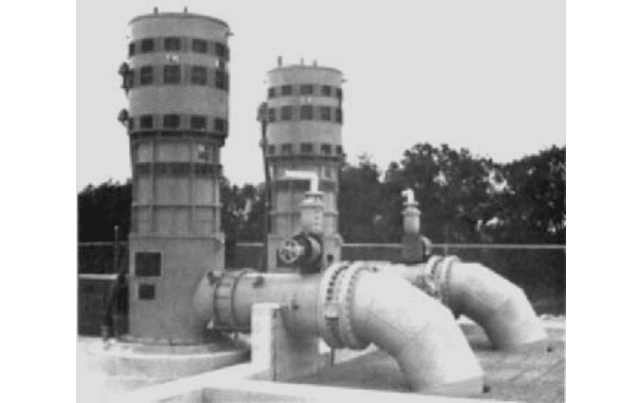
9.1 WATER SUPPLY 9.17
FIGURE 10 Raw water pumping station for North Texas Municipal Water District, showing vertical turbine
pumps with variable-speed drives (Flowserve Corporation)
eductor capacity is then a function of water supply pressure and frictional loss in the feed
lines. Eductors are normally rated according to suction capacity, which must be added to
the amount of flow contributed by the motive fluid in calculating head losses through the
feed system. The manufacturer’s literature should be consulted to determine the water
supply requirements for various sizes of eductors.
Carbon Slurry Pumps Treatment plants that receive raw water from surface sources
often require the addition of activated carbon to combat taste and odor problems caused
by suspended material and microorganisms carried into the supply by floodwaters. Con-
sequently carbon must be stored in ample quantities to supply immediate needs.The acti-
vated carbon is often transferred from storage tanks to a constant-level solution tank in
the form of a slurry. Progressing cavity-type pumps equipped with variable-speed drives
are suitable for this transfer service, provided the proper construction materials are
selected. The range of capacities required is equal to the difference between minimum and
maximum carbon feed rates, and discharge head can be calculated as for any pumping
system. However, selection of operating speed and power requirements must be based on
estimates of the abrasive and viscous characteristics of the slurry.
Fluoride Pumps The addition of hydrofluosilicic acid to drinking water is achieving
growing acceptance in the United States as an effective preventative of tooth decay.
Pumps used for addition of this material should be positive displacement, mechanical
diaphragm, metering pumps constructed of special materials, such as Kralastic, Fenton,
and Teflon. A relief valve should be installed on the discharge line to protect the pump in
the event of a line blockage.
Diaphragm pumps operate on the principle of the linear motion of a flexible
diaphragm, which pulls the solution through an intake port during the backward stroke
and forces solution out the discharge port on the forward stroke. Feed rate can be varied
by adjusting the stroke length or by a multistep pulley belt-connected to the motor driver.
Hydrofluosilicic acid is usually supplied as a slurry that is 20 to 30% hydrofluosilicic acid.
Of this acid, 79% is in the form of fluoride ion. In sizing the fluoride feed pumps, consid-
eration must be given to the following factors:

9.18 CHAPTER NINE
1. Difference between the fluoride ion content of the raw water and that desired in the
finished water
2. Strength of the slurry
3. Specific gravity of the slurry
For example, assume that the fluoride ion content of the raw water is 0.3 parts per mil-
lion (ppm) and the desired concentration in the treated water is 0.8 ppm; that the slurry
is 20% hydrofluosilicic acid with a specific gravity of 1.22; and that the plant raw water
inflow is 100 mgd (15,800 m
3
/h). The required dosage is then
and the amount of slurry needed is
in USCS units
in SI units
Head losses to the point of application can be calculated (with allowances for the vis-
cosity of the slurry) and the proper feed rate accomplished by adjustment of the stroke
length. A diaphragm pump is capable of providing a repeatable accuracy of ;1%, a desir-
able characteristic in light of the fact that excess fluoride in drinking water can produce
harmful rather than beneficial effects on the teeth.
Sampling Pumps Small-capacity centrifugal pumps are generally used for delivery of
samples from various points in the plant to the chemical laboratory for analysis. Capaci-
ties required are generally in the vicinity of 5 to 10 gpm (1.1 to 2.3 m
3
/h). The required
discharge head can be determined from a schematic layout of the suction and discharge
piping, with provision for some 10 to 15 lb/in
2
(70 to 100 kPa) pressure at the chemical
laboratory faucet. Head losses through the system are computed as in any pumping sys-
tem, and such computations are simplified somewhat by the fact that no interconnections
are involved; that is, each sample pump must have a separate discharge line to the chem-
ical laboratory.
Plant Water Pumps Water used for various purposes throughout the treatment plant
is usually taken from the treated water at the end of the process. Such water may be
pumped back directly into the plant water system or to an elevated storage tank that sup-
plies the head required for adequate pressures throughout the plant. In either case, a thor-
ough study of the plant water system is necessary to determine the amount of water
required. The plant water tank can be provided with automatic start and stop controls
based on the water level in the tank to prevent complete draining or overflowing.
Allowances should be made to ensure that the tank is sufficiently elevated to provide
ample pressures at water-consuming devices. Plant water pumps will generally be of hor-
izontal split-case construction and must be capable of filling the elevated tank at rates
determined from analysis of the plant water system.
Wash Water Pumps The procedure for selecting wash water pumps is much the
same as that for plant water pumps. An elevated wash water tank should be sized large
enough to permit backwashing of one filter at a time and should be elevated as neces-
sary to provide the required flows through the wash water piping system. Required
backwash rates vary from about 15 to 22.5 gpm/ft
2
(37 to 55 m
3
/h/m
2
) of filter surface
area. In determining head losses from the elevated tank through the filters, consider-
ation must be given not only to the head losses in piping, valves, and fittings, but also
to the head losses in the filter underdrain system, which may range from 3 to 8 ft (0.9
to 2.4 m) at a backwash rate of 15 gpm/ft
2
(37 m
3
/h/m
2
), depending on the under-drain
system installed and the filter bed. The wash water tank should be sized to allow back-
washing of one filter for approximately 10 mm and should be equipped with controls
for automatically starting and stopping the wash water pumps at predetermined lev-
0.192 ppm 15,800 m
3
>h 10
6
24 h>day 998.3 kg>m
3
72.7 kg>day
0.192 ppm 100 mgd 8.34 lb>gal 160 lb>day
0.8 0.3
10.79210.20211.222
0.192 ppm of slurry
9.1 WATER SUPPLY 9.19
els. The required pumping capacity depends on the estimated frequency and rate of
backwashing.
Wash water pumps may also be used to supply water directly to the backwash piping sys-
tem.The head required in such cases is that needed to overcome all losses in the wash water
piping, underdrain system, and filter bed, and the capacity should equal the maximum back-
wash rate. An air release valve, check valve, and throttling valve should be provided on the
discharge side of the wash water pump, and standby service is highly recommended.
Because the wash water pumps generally use treated water from clear well storage,
horizontal centrifugal pumps should be used only when positive suction head is available.
Otherwise, a vertical pump unit may be suspended in the clear well.
Surface Wash Pumps Manufacturers of rotary agitators for surface wash systems gen-
erally specify a minimum pressure for proper operation of their equipment. This pressure
[generally from 40 to 100 lb/in
2
(280 to 690 kPa)] must be added to the system piping losses
in determining head requirements for surface wash pumps. The required discharge may
vary from 0.2 to 1.5 gpm/ft
2
(0.5 to 3.7 m
3
/h/m
2
) of surface area, depending on the supply
pressure, size, and type of agitator supplied.
High-Service Pumps High-service pumps at a water treatment plant are those pumps
that deliver water to the distribution system. The term water distribution system as used
herein is defined as embodying all elements of the municipal waterworks between the
treatment facilities and the consumer. The function of the distribution system is to pro-
vide an efficient means of delivering water under reasonable pressure in volumes ade-
quate to meet peak consumer demands in all parts of the area served.
High-service pumps may be of either vertical or horizontal construction, depending on
the required capacity and the design and configuration of treated water storage facilities
from which the pumps take suction. The high-service pumping station often houses the
plant water and wash water pumps in addition to the high-service pumps because all such
pumps utilize treated water to perform their required services (Figure 11).
Operating conditions in the distribution system play an important role in the determi-
nation of high-service pump capacities. In small municipalities, for example, it may be pos-
sible to pump from the treatment plant at a constant rate equal to the average daily
demand and to supply peak demands from elevated storage tanks throughout the system.
However, as systems become larger, the need for variable-rate pumping from the treatment
plant increases. If sufficient storage is available in the distribution system for supplying
peak hourly demands, it may be possible to provide variable-speed high-service pumps
with total capacity equal to the maximum capacity of the treatment plant and to supply
hourly peaks from storage. However, inasmuch as peak hourly demands may be two or
more times as great as the peak daily demand and may be sustained for several hours, the
required system storage for such operation can exceed 30% of the maximum daily demand.
In very large systems, provision for this amount of storage is simply impractical. It may
then become necessary to design treatment facilities for capacities in excess of the maxi-
mum daily demands and to supply only a portion of the peaking water from storage.
In any event, as distribution systems become larger, variable-speed pumping becomes
more desirable and development of a system-head curve becomes more complex. In many
cases, pumpage from treatment plants during off-peak hours exceeds pumpage during
peak hours because storage tanks must be filled during off-peak hours. System-head
curves must be derived for each of the previous conditions and also for a third condition,
which represents those periods when storage tanks are full but are not being utilized to
supply demands.Typical system-head curves for all three conditions are shown on Figure
12. Only a thorough analysis of the entire distribution system can provide the data nec-
essary for the proper selection of high-service pumps.
BOOSTER PUMPS IN DISTRIBUTION SYSTEMS___________________________
In order to maintain distribution system pressures within the desirable 40- to 90-lb/in
2
(275- to 620-kPa) range, booster pumps may be required at various locations, as dictated
